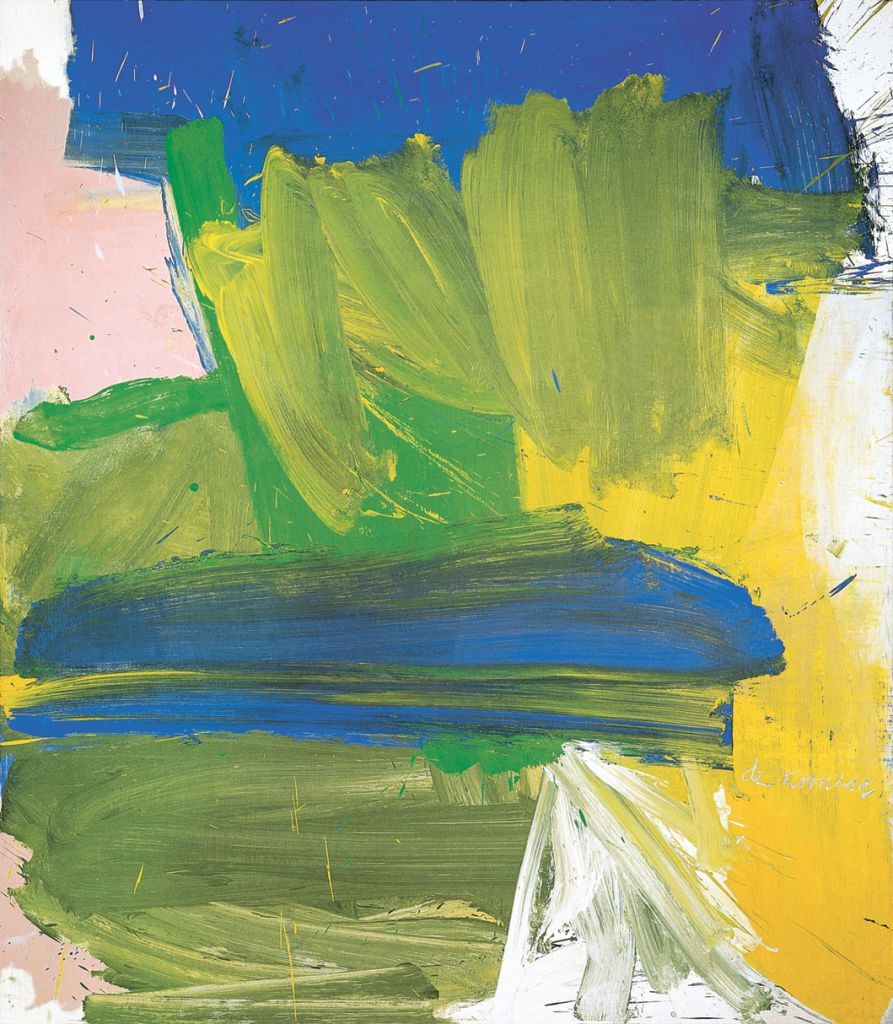
Villa Borghese
"Just coming around roads, some place, and having the sensation of a piece of it, a piece of nature, like a fence, something on the road. And I really get very elated by again looking, by again seeing that the sky is blue, that the grass is green."1
Willem de Kooning, Villa Borghese, 1960.
Oil on canvas, 203-178 cm.
Guggenheim Bilboa Museoa
Following the end of World War II, art making changed in Europe and beyond. In the United States—especially New York, the new center for avant-garde art worldwide—artists moved toward a gesture-based, expressive style known as Abstract Expressionism. These artists were interested in process and materials as well as tapping into their own unconscious and emotional states of mind.
While most Abstract Expressionists eventually shunned references to the real world in favor of internal expression, Willem de Kooning (1904-1997) returned to the external world for inspiration in his abstract paintings. De Kooning was criticized by his peers for this move back to representation, which was considered regressive. From 1950 to 1955, he completed his famous Women series in which he integrated the human form with aggressive paint application, bold colors, and experimentation. Then, in the latter half of the 1950s, he turned to landscape, first, the urban surroundings of his studio in downtown Manhattan and later, a more pastoral setting outside New York and near the Atlantic Ocean.
Villa Borghese (1960) was inspired by a landscape in Rome, where De Kooning spent approximately five months during 1959 and 1960. The painting's title alludes to a famous public park, which includes a lake and several fountains. The work's Mediterranean color palette suggests the sun, sky, water, and grass that De Kooning may have remembered from his trip. The painting was not made on-site but after the artist had returned to New York, making it more of a subjective translation of his memories than a depiction of any particular view. 2
Notes
1- "Willem de Kooning. A Tree in Naples. 1960," Museum of Modern Art, The Collection, accessed May 26, 2011.
2- "Villa Borghese," Guggenheim Museum Bilbao, The Collection: Our Own Collection, accessed May 26, 2011.
Preguntas
- Look together at De Kooning’s Villa Borghese. Ask students what they notice about it. Be sure to discuss the brushstrokes, colors, and size. (To make clear its size, point out the dimensions listed in the caption and compare them to an object in the classroom.)
- What associations do the colors evoke for your students? Ask them to give the colors names as if they worked for a paint company (such as canary yellow). What sounds, smells, or tastes do they conjure?
- Ask students to look carefully at the brushstrokes. How would they describe them? What mood do they evoke? How do students think De Kooning had to move to create this painting?
- Tell students the painting’s title and that it was inspired by a large public park that the artist had visited in Rome. The park features fountains, a man-made lake, wide shady lanes, foliage, temples, statues, and museums. What aspects of the park, if any, can they see echoed in the painting?
- Look together at pictures of Villa Borghese and ask students to continue these comparisons.
- De Kooning painted this work after he returned to his home in New York. Ask students what they think the difference is between painting a subject while it is in view versus painting based on memory. How might the work have been different if it were painted on-site?
- De Kooning was often criticized for moving from abstract works that expressed internal, psychological states to those inspired by the world around him. Ask students to discuss the advantages or disadvantages of each approach.
